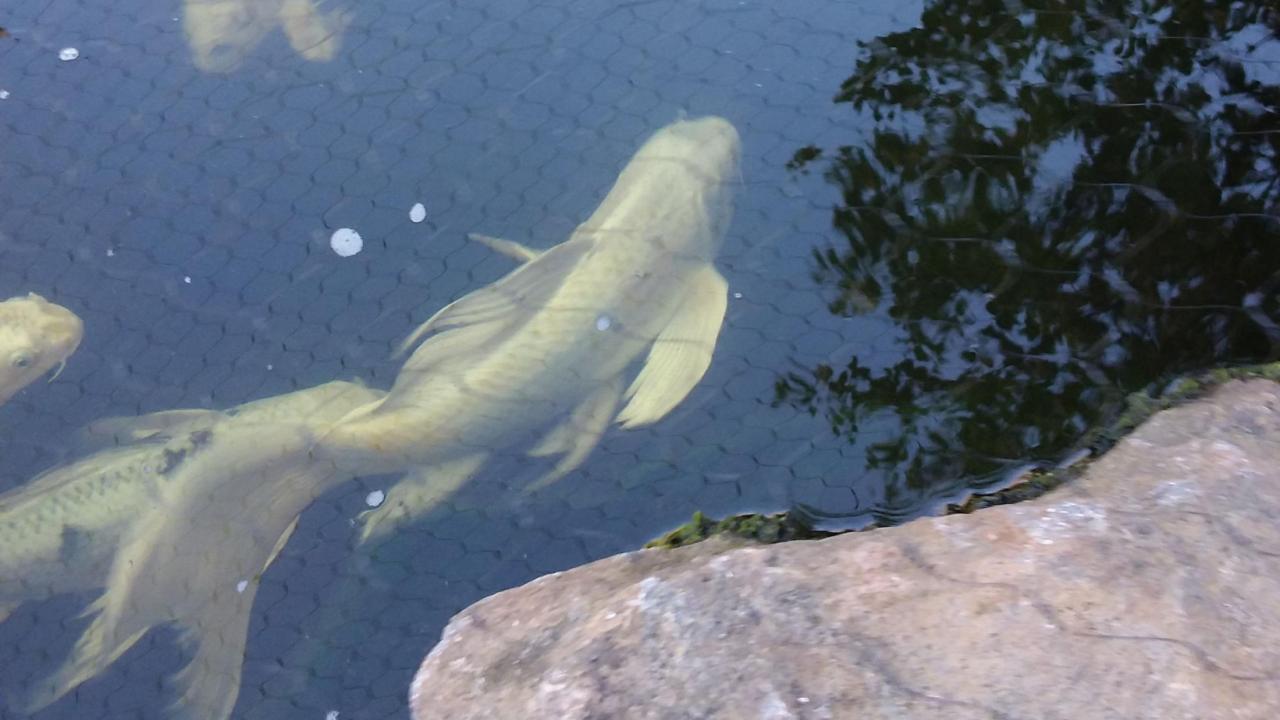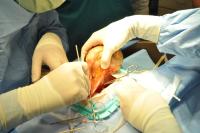
UC Davis Veterinarians Remove Softball-Sized Tumor from Fish
“Case of the Month” – October 2018
Madonna, a 6-year-old suspected female koi fish, lives a peaceful life with more than 20 other fish in an outdoor pond in Northern California. Her owners have been keeping koi for more than 25 years and enjoy the hobby tremendously. When Madonna’s abdomen recently became distended, she was examined by the UC Davis veterinary hospital’s Aquatic Animal Health Unit of the Companion Exotic Animal Medicine and Surgery Service.
The koi’s behavior was normal and she was eating well, so veterinarians thought the distension was likely caused by egg-binding in her body cavity. Other possibilities, however, were a cancer of her ovaries or other organs or fluid accumulating in her body.
Madonna was injected with a spawning agent medication that would make her spawn within a few days. Her owners were told to monitor her for any signs of diminishing health, like a change in her appetite, swimming behavior, or buoyancy changes. If she did not spawn after the injection, the veterinarians planned to have her transported to UC Davis for further diagnostics, including radiographs and ultrasound.

After not spawning, Madonna underwent imaging procedures with Drs. Kathryn Phillips and Kelsey Brust of the hospital’s Diagnostic Imaging Service. Ultrasound showed a large mass filling the majority of her abdomen, the origin of which was unknown. Veterinarians concluded that possible tissues of origin included gonadal tissue, or less likely, from her liver or gastrointestinal (GI) tract. To further define the tissue of origin and get better detail of the mass itself, Madonna was given a computed tomography (CT) scan.
The CT scan showed an extensive mass, with inability to view any normal liver, GI tract, or gonads. The mass had fluid-filled regions and extended forward, pushing on her heart.
Due to the size of the mass and lack of normal structures within the abdomen, aquatic specialist Dr. Esteban Soto informed Madonna’s owners that the prognosis was poor. Surgical removal of the tumor could be attempted but would carry a high risk of complications.
As Madonna’s owners were interested in helping the school further its knowledge of koi and how to treat this disease, they chose to proceed with the surgery to remove the tumor.
Dr. Soto, along with other exotic veterinarians Drs. June Ang, Samuel Frei, and Molly Gleeson performed a 90-minute surgery. To keep Madonna anesthetized and alive while out of the water, the team used a pump that allows anesthetized water to flow through a tube into Madonna’s mouth and perfuse her gills. The delicate balance to keep Madonna from not being too deep or too light under anesthesia was monitored closely throughout the procedure. Veterinarians kept a close eye on her opercular rate—that indicates respiration in fish—and used Doppler to monitor the flow of blood through her heart. If they did not see opercular rates (or saw lowered rates), they were prepared to remove the tube with anesthetized water and replace it with a fresh water tube to start taking Madonna off anesthesia.
Madonna remained stable under anesthesia for the entire surgery, and the veterinarians were able to safely remove a softball-sized, 1.1-kilogram gonadal tumor, nearly half her total body weight of 2.3 kilograms.
A large incision on Madonna’s underside was sutured, and she was transported to the UC Davis Center for Aquatic Biology and Aquaculture (CABA), located on campus near the veterinary hospital. CABA has dozens of large tanks, some nearly as big as Madonna’s home pond. The center was critical to the veterinary school’s efforts to save abandoned koi during the 2017 Napa fires, housing 33 fish that were rescued by Dr. Soto and the school’s Veterinary Emergency Response Team (VERT).
Madonna started eating and swimming at CABA shortly after the surgery. She continued to improve and had her sutures removed three weeks after surgery. She was monitored for another week at CABA before she was returned to her home pond, where she is now back with her family. Dr. Soto recently performed a 10-week recheck examination at her home and found her to be in great health.
Koi can make great pets, but potential owners should understand the level of work involved in keeping them healthy. And also realize that koi can live for more than 100 years. Many of the koi rescued by VERT during the Napa fires were estimated to be between 30-70 years of age.
# # #
